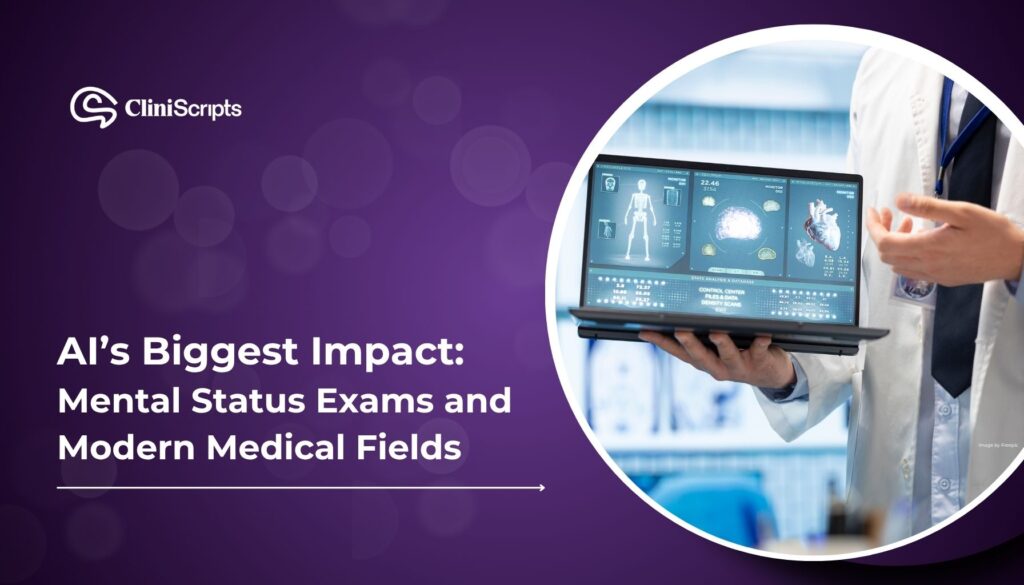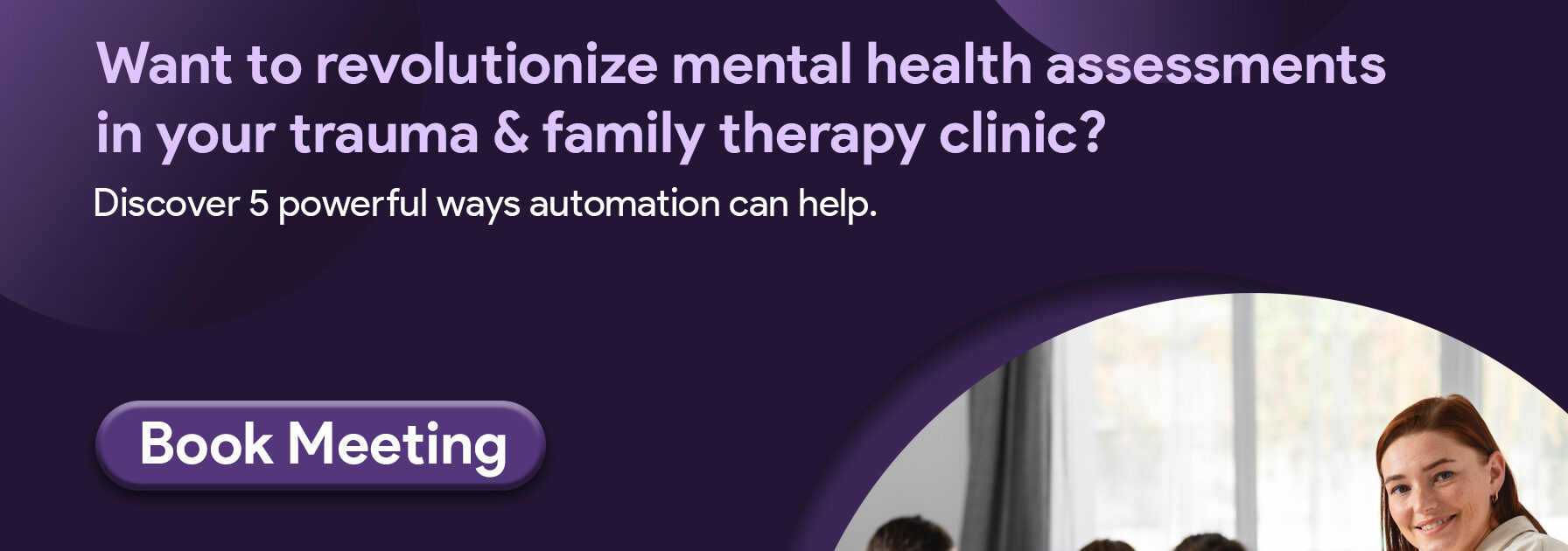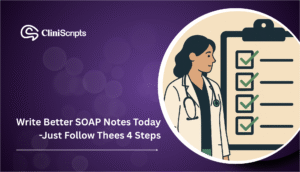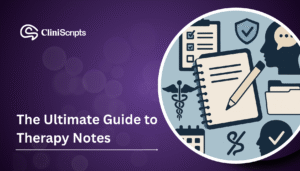AI is revolutionizing therapy notes and mental health assessments. Discover how automated documentation and enhanced mental status exams are changing care delivery.
AI technology is quickly becoming a crucial tool in healthcare, not only in diagnostics but also in documentation, workflow automation, and initiations of care. The use of AI to process large data sets and detect patterns has proven useful in already strained health care systems (like mental health care) where demand is increasing and resources continue to be limited.
From improving therapy notes along the continuum of care to better supports for the Mental Status Exam, AI is quietly transforming our care delivery- one algorithm at a time.
Smarter Documentation: From Therapy Notes to Mental Status Exams
A global reality in the field of healthcare is an administrative burden. In mental health, one of the most time-consuming activities of a practice is clinical documentation. After a therapy session, therapists must prepare therapy notes that accurately capture the “who”, “what”, and “how” to reflect specifically on the treatment a patient is receiving.
AI-driven note-taking systems help therapists manage documentation by creating transcripts of their session in real-time, surface important concepts, and even allow the therapist to organize their notes according to a well-known therapy framework (e.g., CBT). In addition to being a time saver,AI-driven note-taking systems can help lessen clinician burnout and increase accuracy. Ultimately, AI-driven note-taking systems allow therapists to spend more time focused on their patient, versus their evenings trying to remember what happend during the day so they can catch up on documentation.
From streamlining therapy notes to enhancing the Mental Status Exam, AI is quietly revolutionizing how care is delivered—one algorithm at a time.
How AI Enhances Mental Status Exams in Mental Health
Artificial intelligence has some powerful and practical implications for mental health care, particularly in relation to automating clinical documentation. Writing therapy notes represents some of the most time-consuming work for therapists. While required to ensure compliance and continuity of care, the time it takes to complete documentation is frequently one of the least gratifying aspects of therapeutic work. In fact, providers spend a considerable amount of their professional time—estimated at nearly 30%—on documentation alone (National Library of Medicine, 2021).
With the recent introduction of AI-driven tools designed specifically for therapy note-taking, clinicians can proactively remove much of the burden of documentation. AI technology is at a point where it can now record and transcribe therapy sessions automatically. The recordings are then intelligently processed into complete, pristine, and well-organized therapy documentation that highlights important aspects of the session. Some documentation applications are even able to determine the appropriate therapeutic model—CBT, DBT, etc.—of the session by analyzing its content, allowing for consistent formatting and categorization.
As noted previously, therapy note generation is legally required, but so is the reflection on the client-therapist relationship which can be more feasible when documented time has been automated. When a therapist is able to automate such documentation to the minimal acceptable standard of quality and set formatting, it provides the therapist with a considerable amount of time to re-invest into the client relationship. Let’s say that ten full minutes of time per note is saved: over the course of a week, that’s a significant amount of time back, and emotional fatigue reduced.
Furthermore, automated documentation usually leads to efficiency improvements, but it can lead to improvements in accuracy, standardization, and clinical content in clinical notes. This can be particularly important in high-volume practices. Inconsistent or missed documentation can result in inconsistencies in care quality.
At the same time, some AI tools are being developed to integrate automated documentation with other assessment activities such as facilitating Mental Status Exams. In this way, combining a standardized assessment with automated documentation should reduce the risks of missing subtle clinical, or therapeutic, information during therapy sessions, which is particularly important in community mental health settings where treatment can be fast-paced. Such technology captures objective findings, while also ensuring the nuance of therapeutic note-taking is accurately documented in therapy progress-notes, enhancing any additional future treatment planning.
Predictive AI for Mental Health and Mental Status Exams
The Mental Status Examination (MSE) is an important standardized assessment of a patient’s cognitive, emotional, and behavioral state which assesses appearance, speech, mood, thought processes, perception, cognition, and insight. The MSE is one area that could benefit from AI.
AI can assist providers in a number of ways:
• An AI-powered tool can suggest follow-up questions in real time.
• An AI-powered tool can transcribe the patient’s responses in structured data.
• An AI-powered tool can detect changes in speech patterns or emotional tone.
For example, researchers at Stanford University have shown how AI models that are trained based on thousands of clinical interactions can help identify early indicators of psychosis or cognitive decline simply by analyzing natural language and vocal cues (Source: Stanford Medicine, 2022).
AI tools can provide a structured form of support in a MSE while supporting the clinician’s clinical skills and therapeutic relationship.
Predicting Risk Before It’s Visible
The long historical data that AI can analyze can help mitigate risk and signal early disease detection. One breakthrough is called Deep Patient, built at the Icahn School of Medicine at Mount Sinai, was trained on the records of 700,000 patients (noting that Deep Patient detected liver cancer, and risk for ever having schizophrenia – before patients had a single symptom, so even before they went to see a doctor) (Source: Nature Scientific Reports, 2016).
In rural and underserved areas, with limited access to specialists, an AI model could serve as a first-line tool to have individuals file a risk sort from clinical outcomes and make recommendations for treatment and want to address what they think the risk is, again with mental health risk would be useful in tell individuals who high risk towards something early and type them to care before criss becomes elevated.
Beyond the Clinic: AI in Drug Development
Artificial intelligence has transformed how we conceptualize drug development–in addition to what we do in our clinical practice each day. The drug discovery process is long and expensive, typically taking 10-15 years and many billions of dollars. We now have AI algorithms that allow us to accelerate the understanding of promising compounds (for example, Atomwise and Recursion Pharmaceuticals) and to do so with more confidence.
The accelerated timeline in drug development, specifically in the context of psychiatric and neurological disorders, is important for ethical bioethics. The development of drug therapy has historically taken 10-15 years, which exceeds the timeline deemed ethically appropriate (and the timeline for which patients can tolerate). With better algorithms and larger datasets facilitated by AI, we hope to come to an understanding of personalized strategies to treat these illnesses and allow the use of patient phenomenology and real world evidence.
The Good, the Bad, and the Ugly
Drawing upon research synthesizing the positive aspects of AI in Telehealth, with benefits include:
– AI has the potential to add clarity
– AI can enhance accuracy
– AI can better facilitate access
Challenges: Privacy, Security, and Training
Though promise, AI, hasn’t reached there yet, there are barriers to overcome:
– Privacy implications compete with strict regulations like HIPAA in the U.S. and PIPEDA in Canada.
– Bias in training data: AI and ML methods can made poor conclusions if the data source is not diverse data-driven training data based on zip code, may be biased depending where clients lived.
– Readiness of workforce: providers in healthcare need training to work with the technology, instead of against it.
Interestingly, Gartner has reported that while manufacturing utilizaing AI may have seen job loss, healthcare is a sector that has been considered to see net job gain because of AI utilization (Source: Gartner Healthcare AI Report, 2023).
Final Views: Partner, not replace
The future of healthcare isn’t about AI taking over clinicians. It’s about AI helping clinicians. AI has potential for: operationalizing your therapy notes, improving Mental Status Exams, helping clinicians make faster decisions, more accurate decisions to support patient care.
Clinicians who will welcome this change to the positivity of the potential AI use will have more time, less data processing, and tools that will improve their therapeutic judgement.










